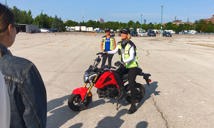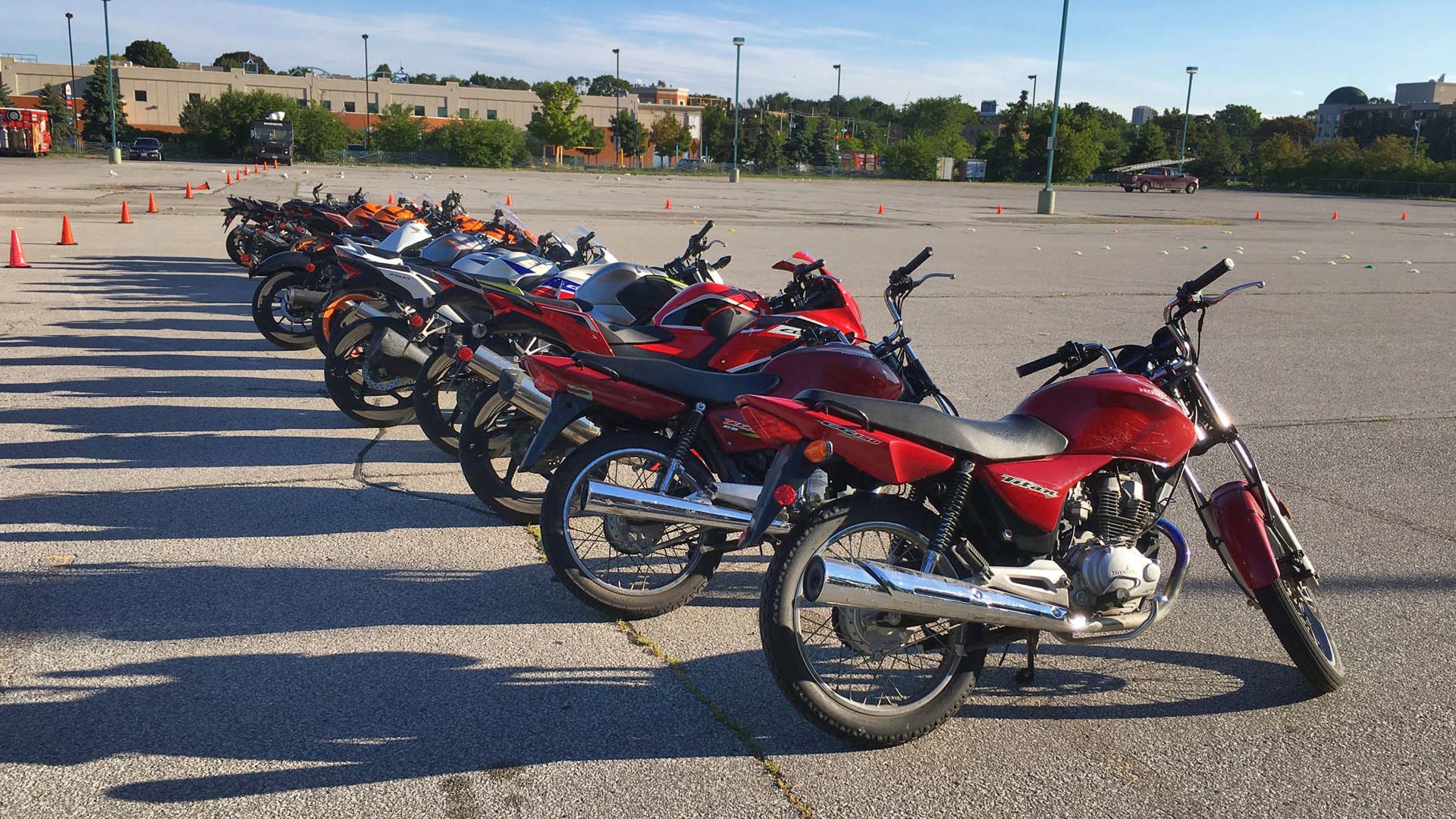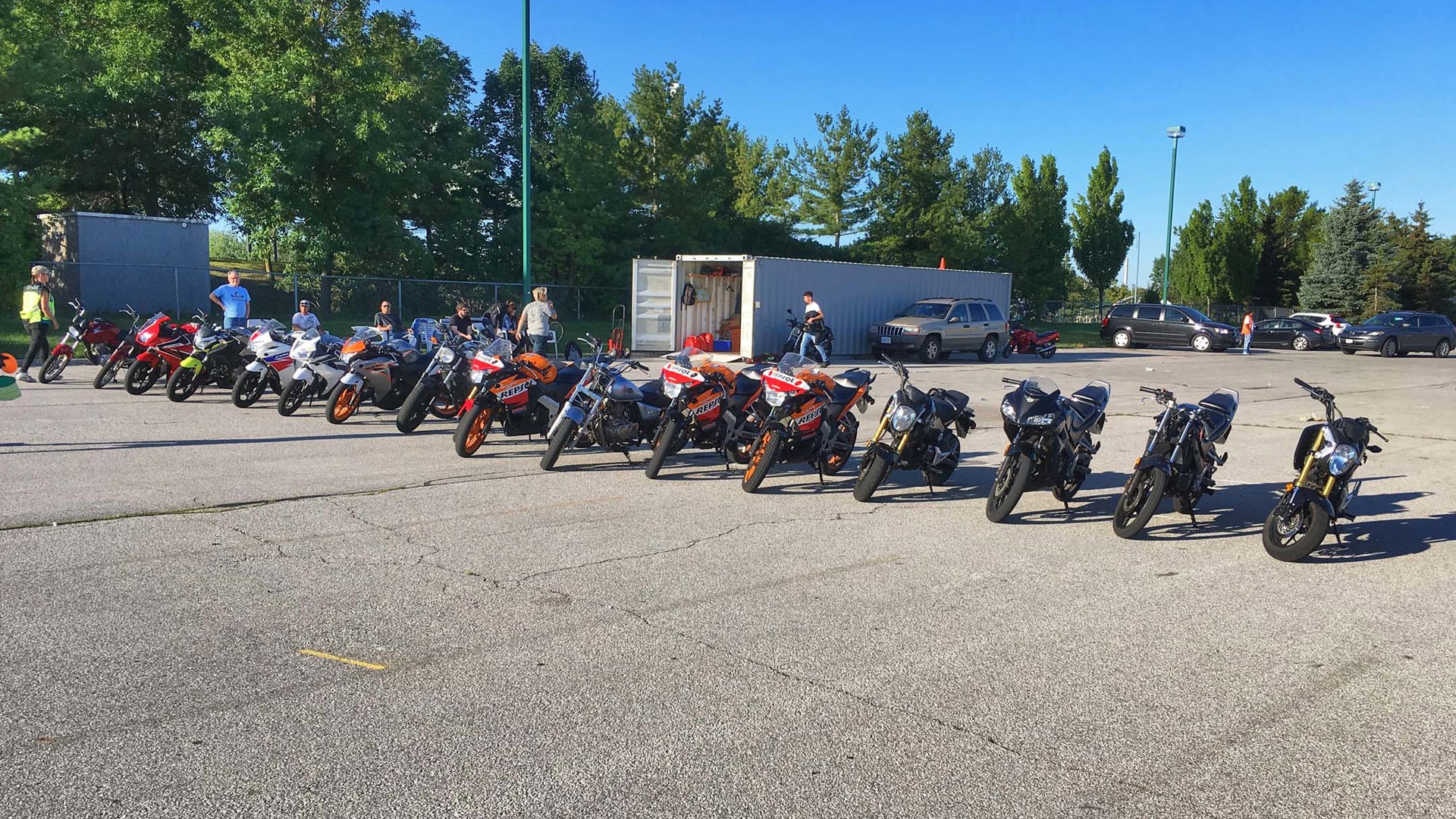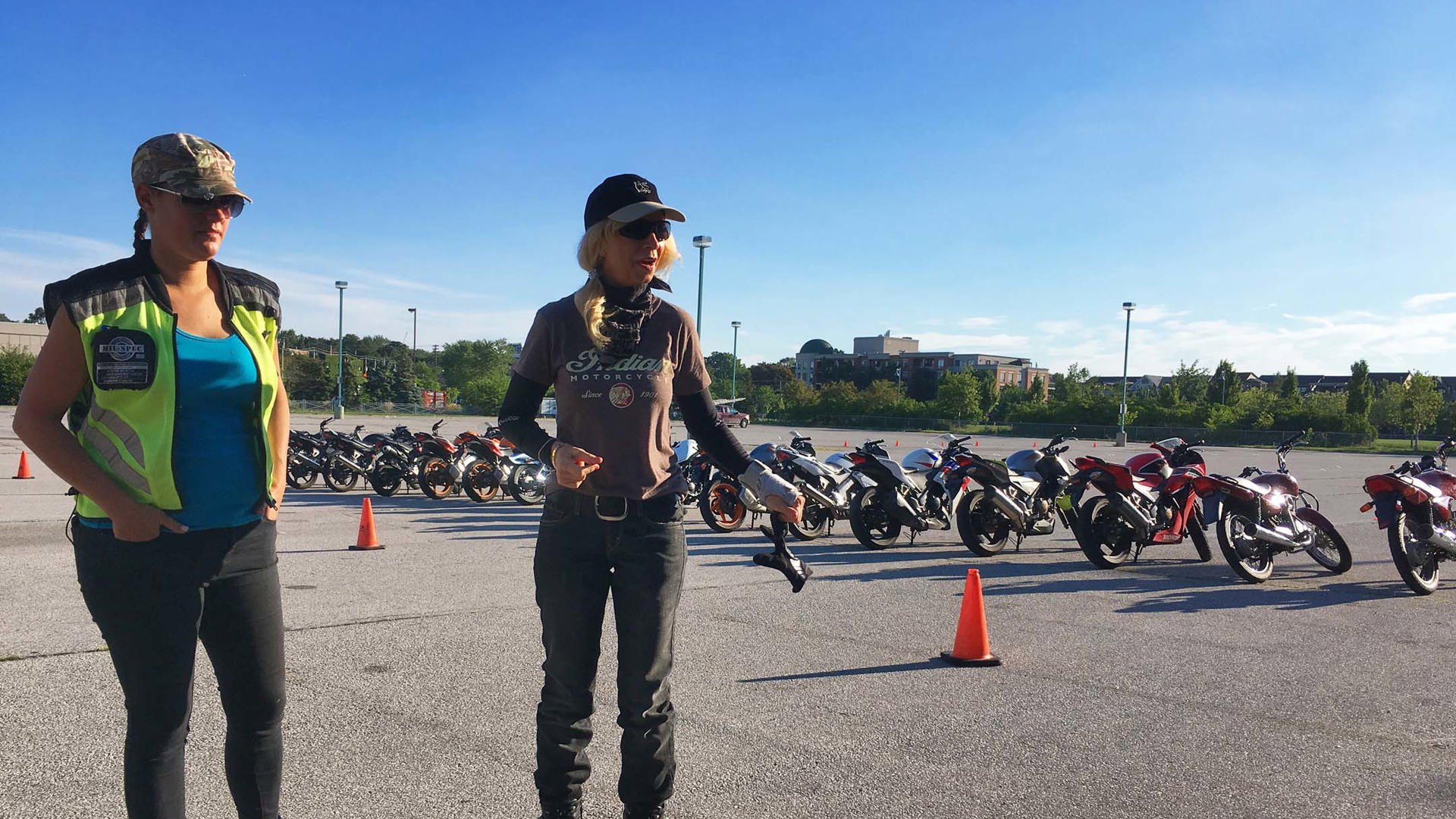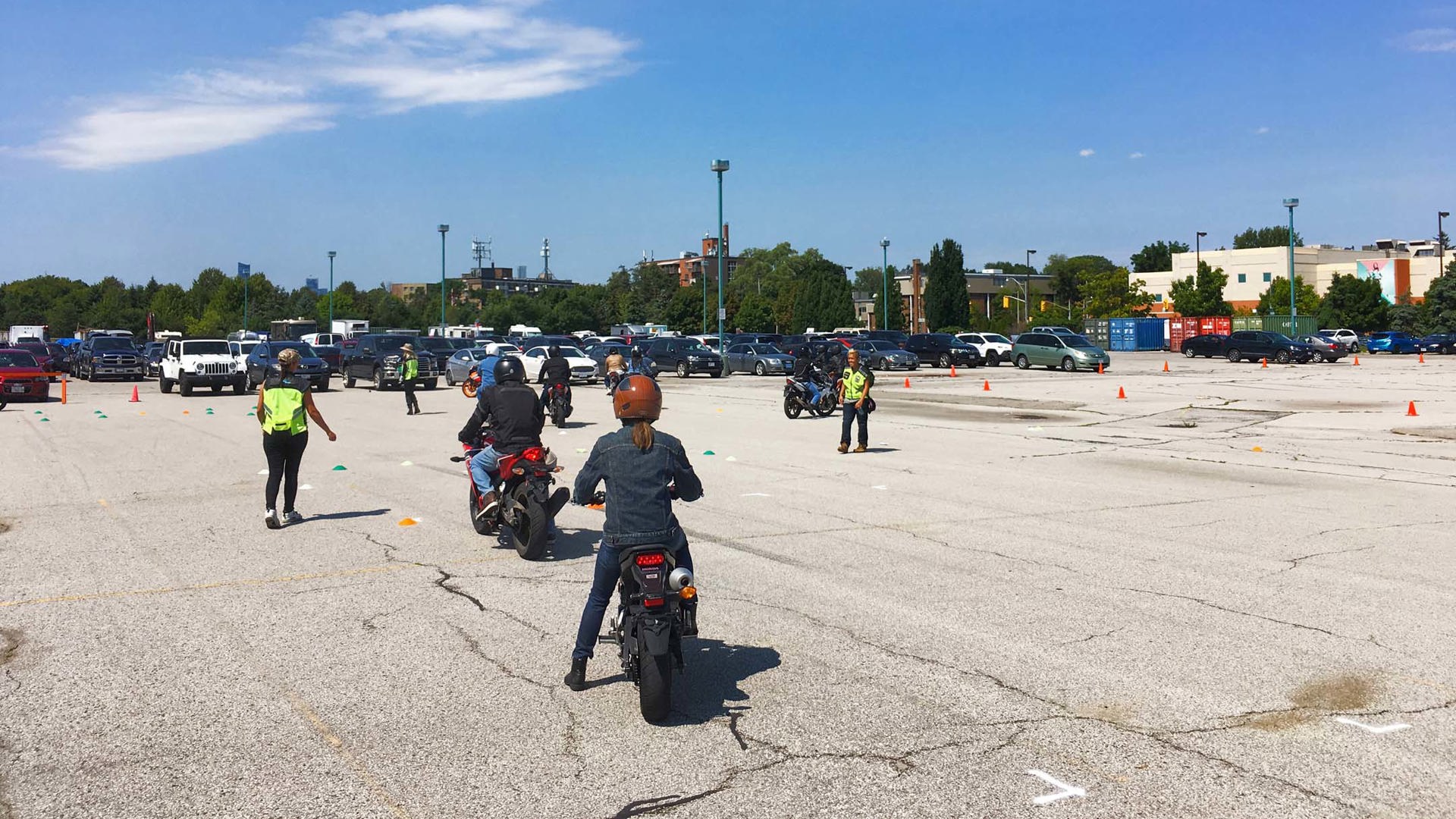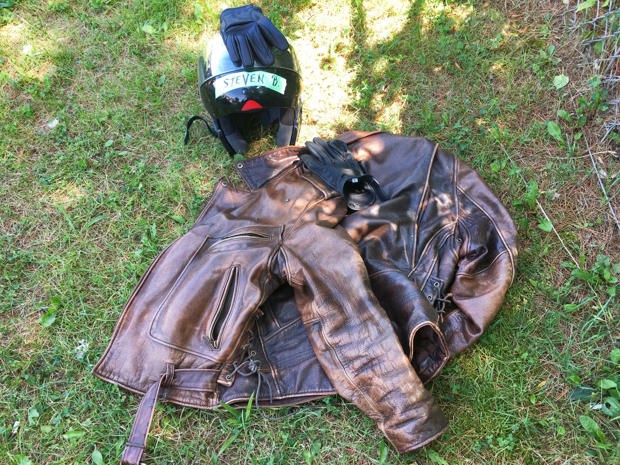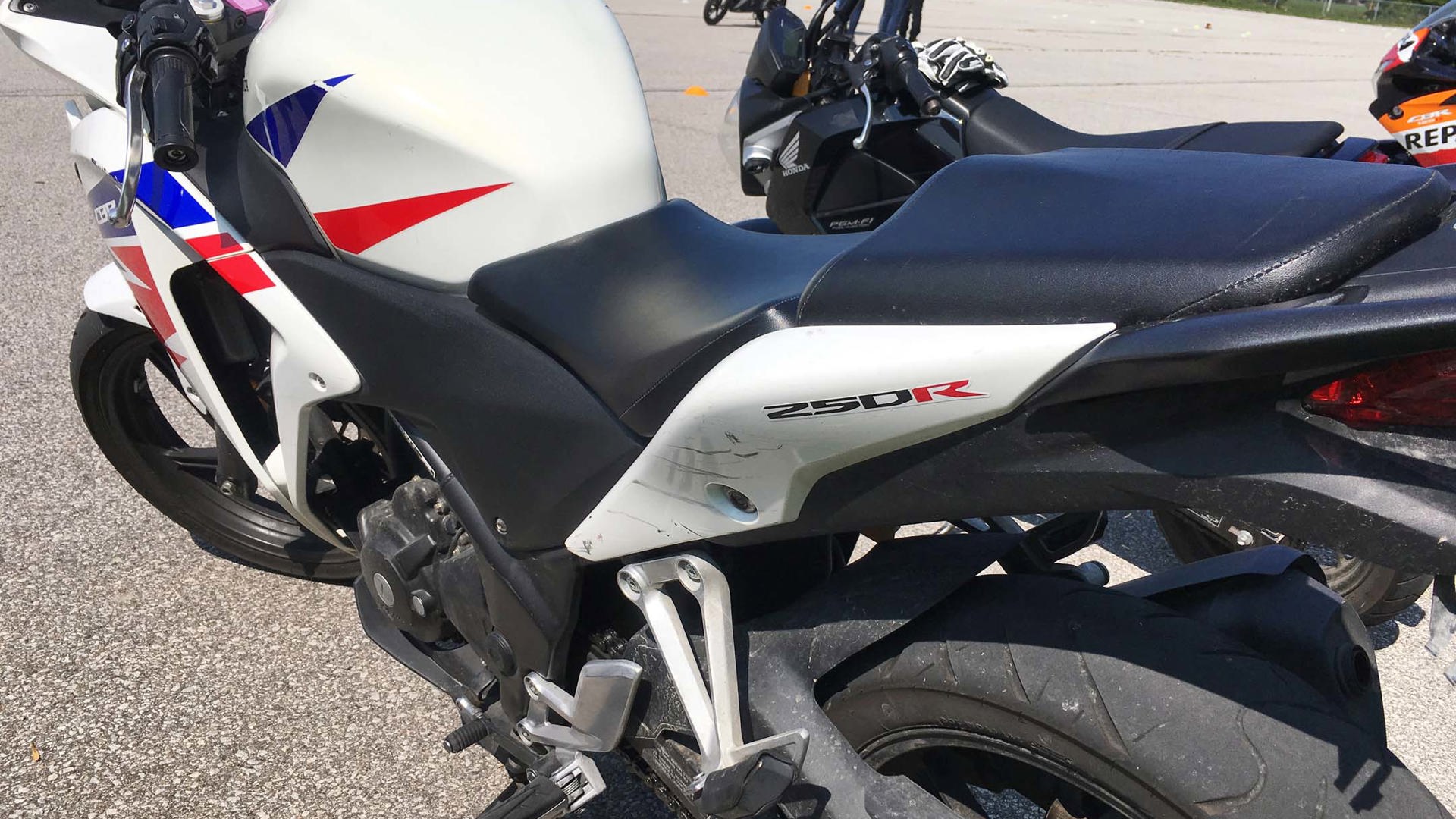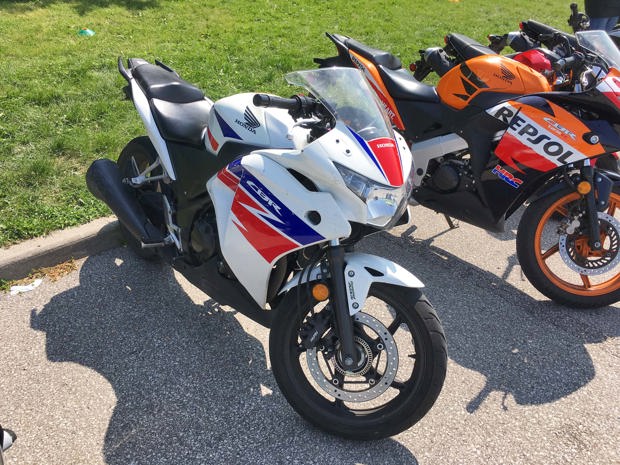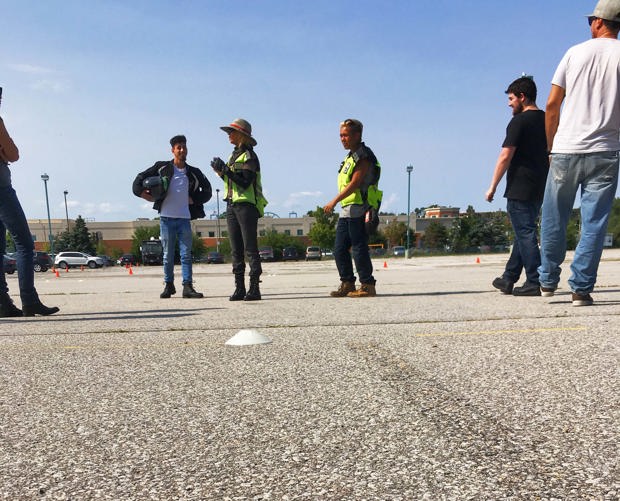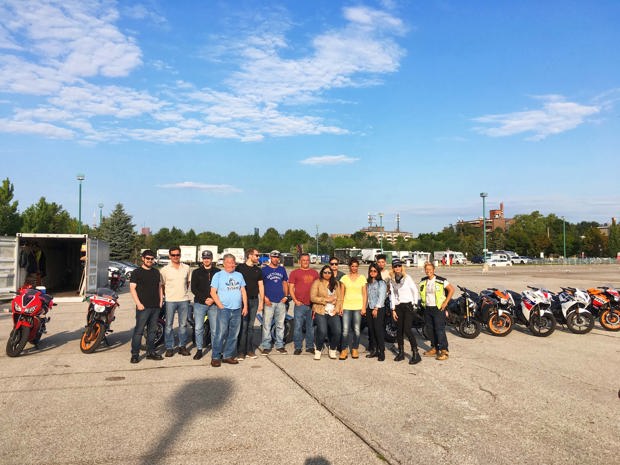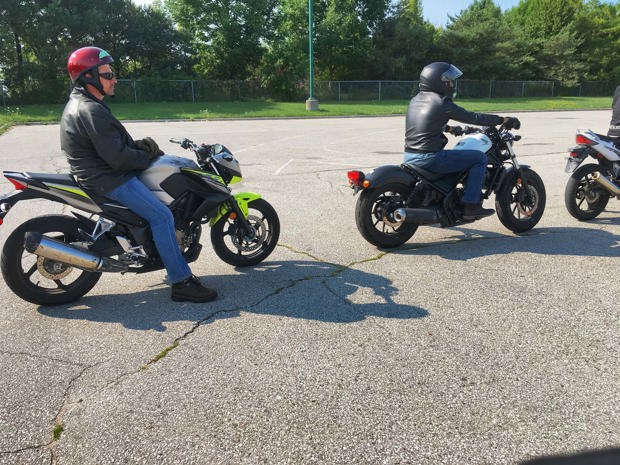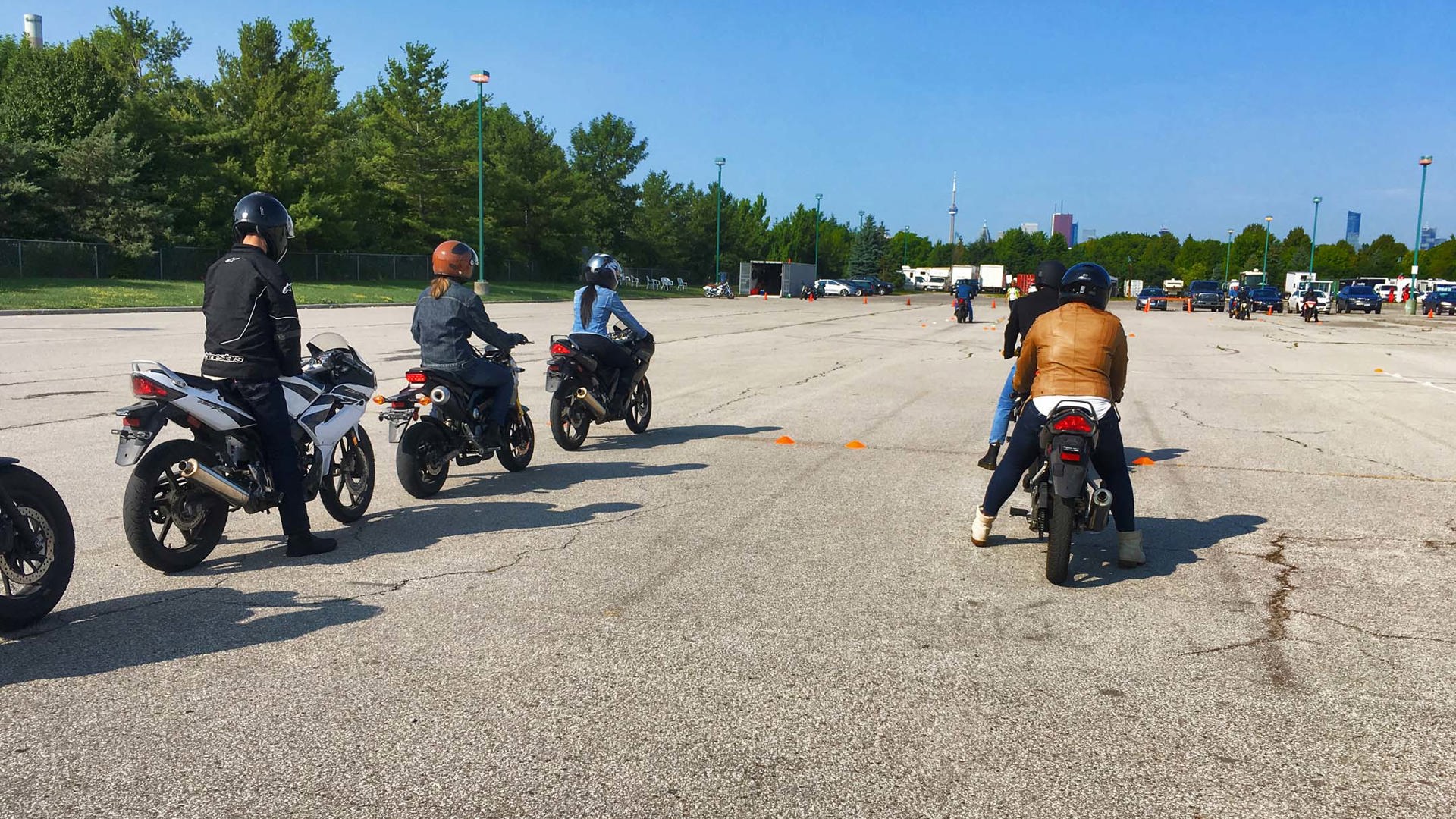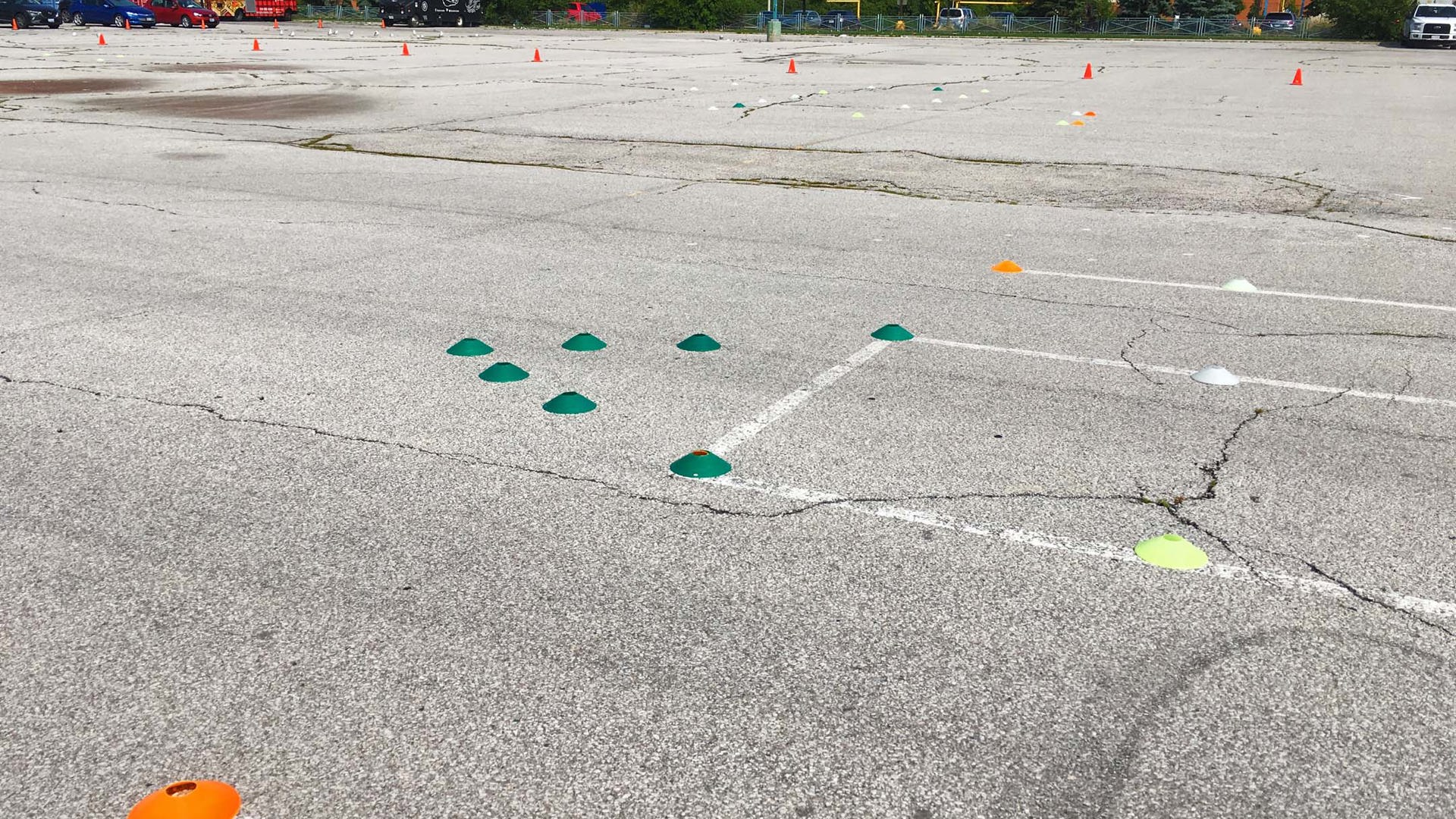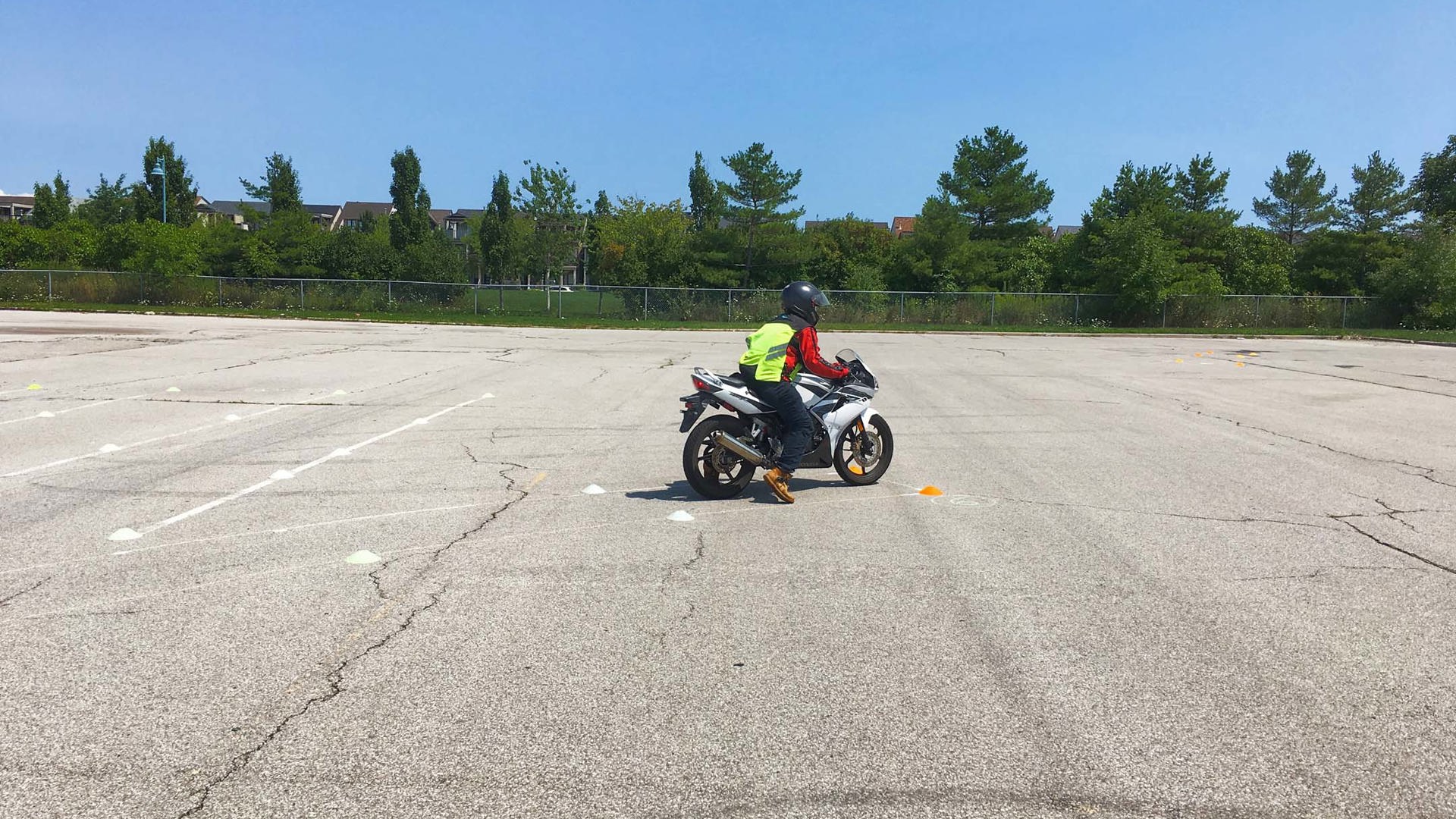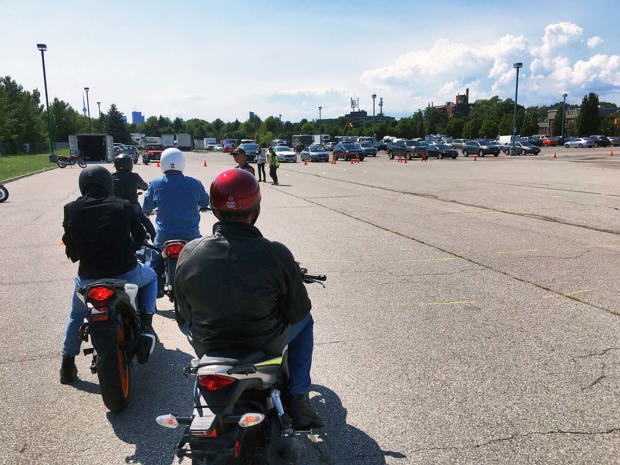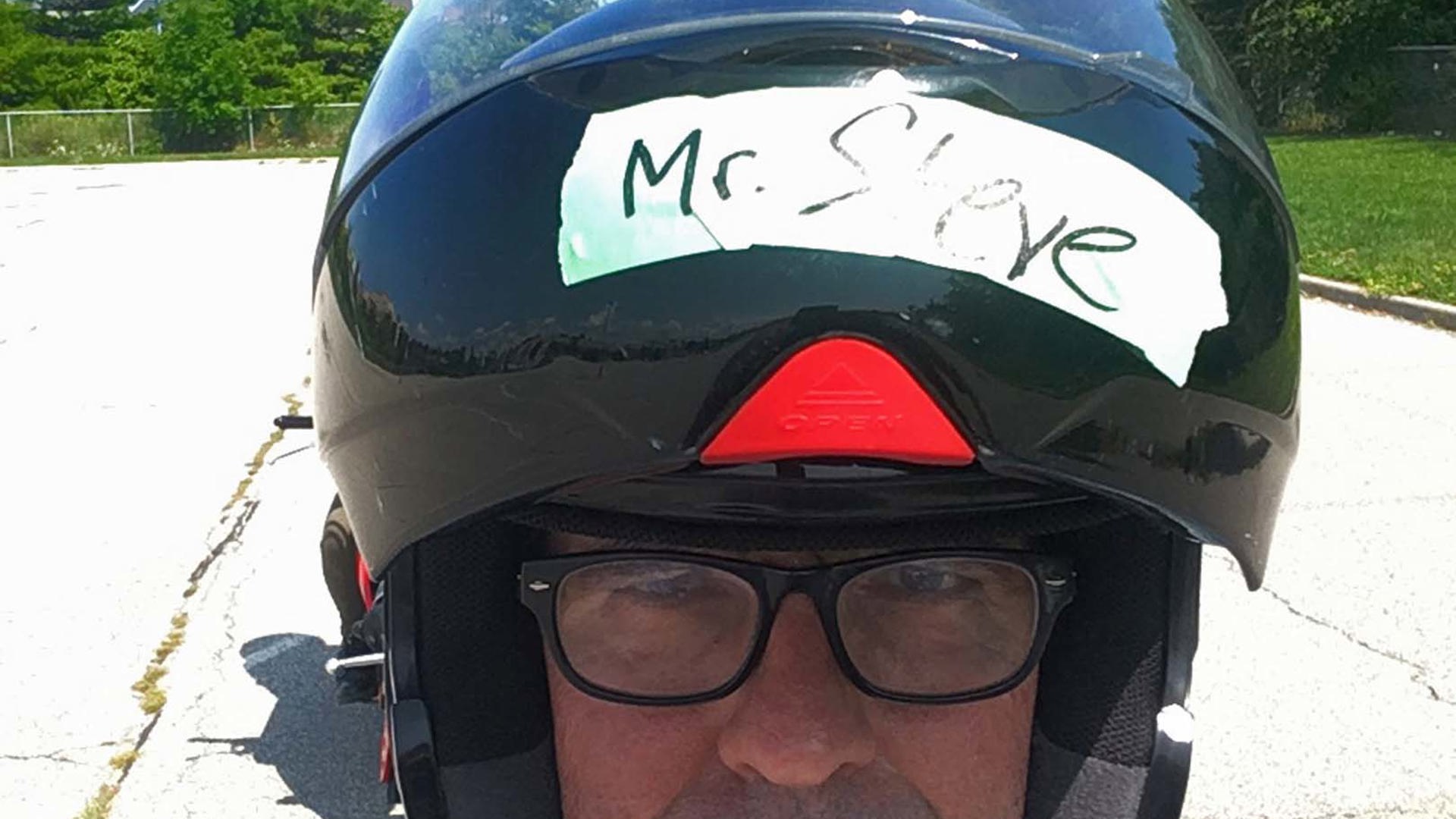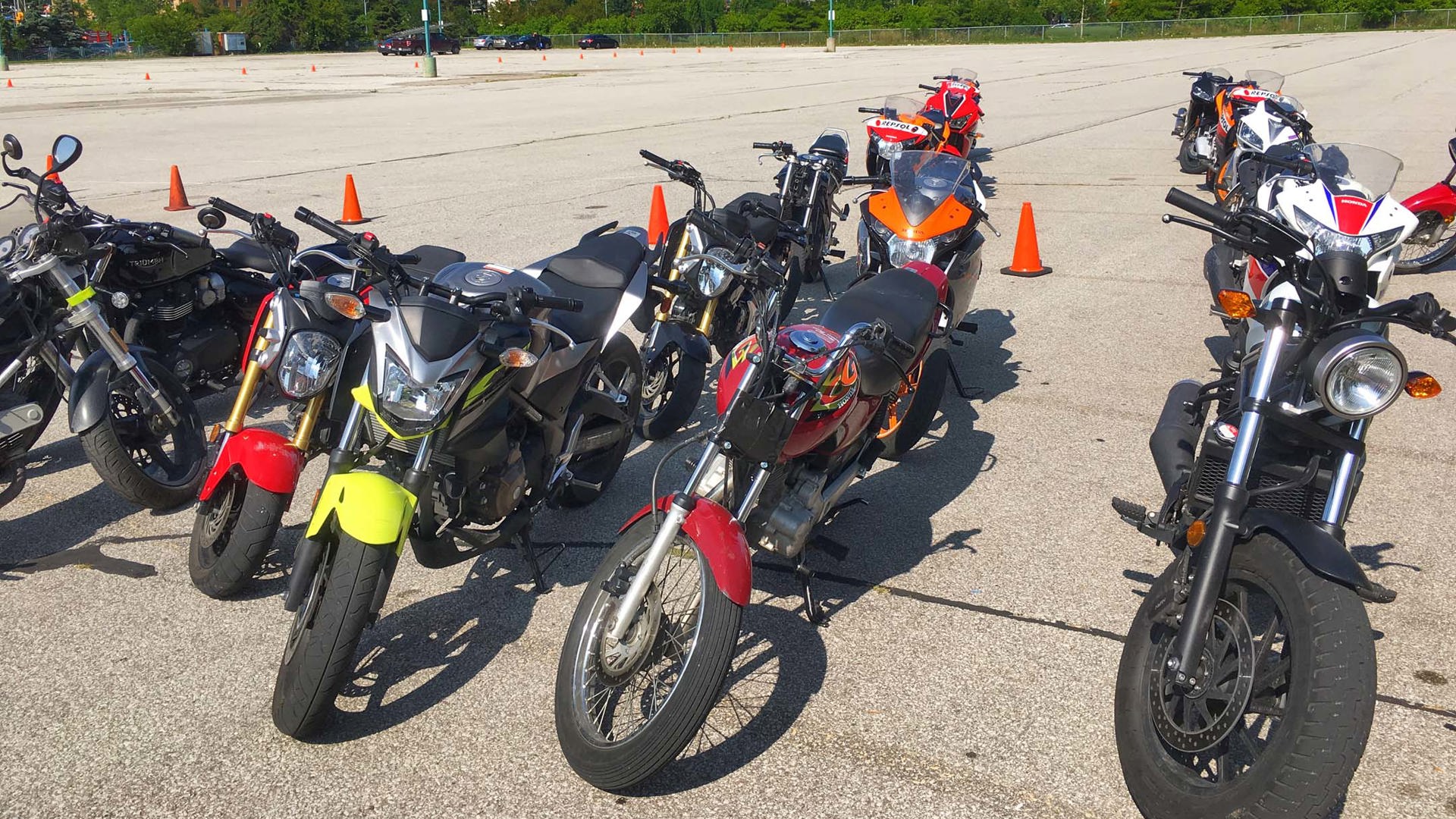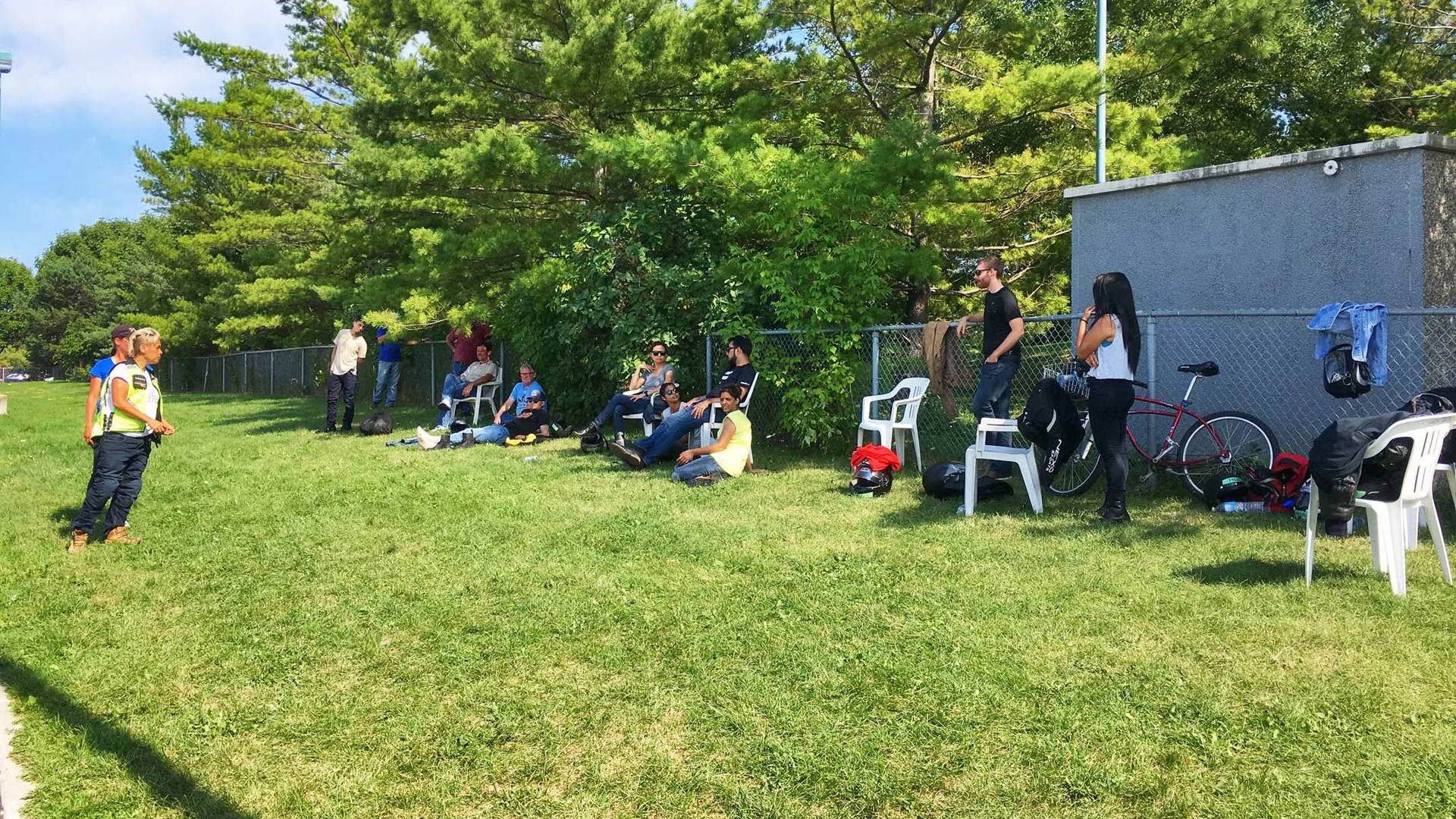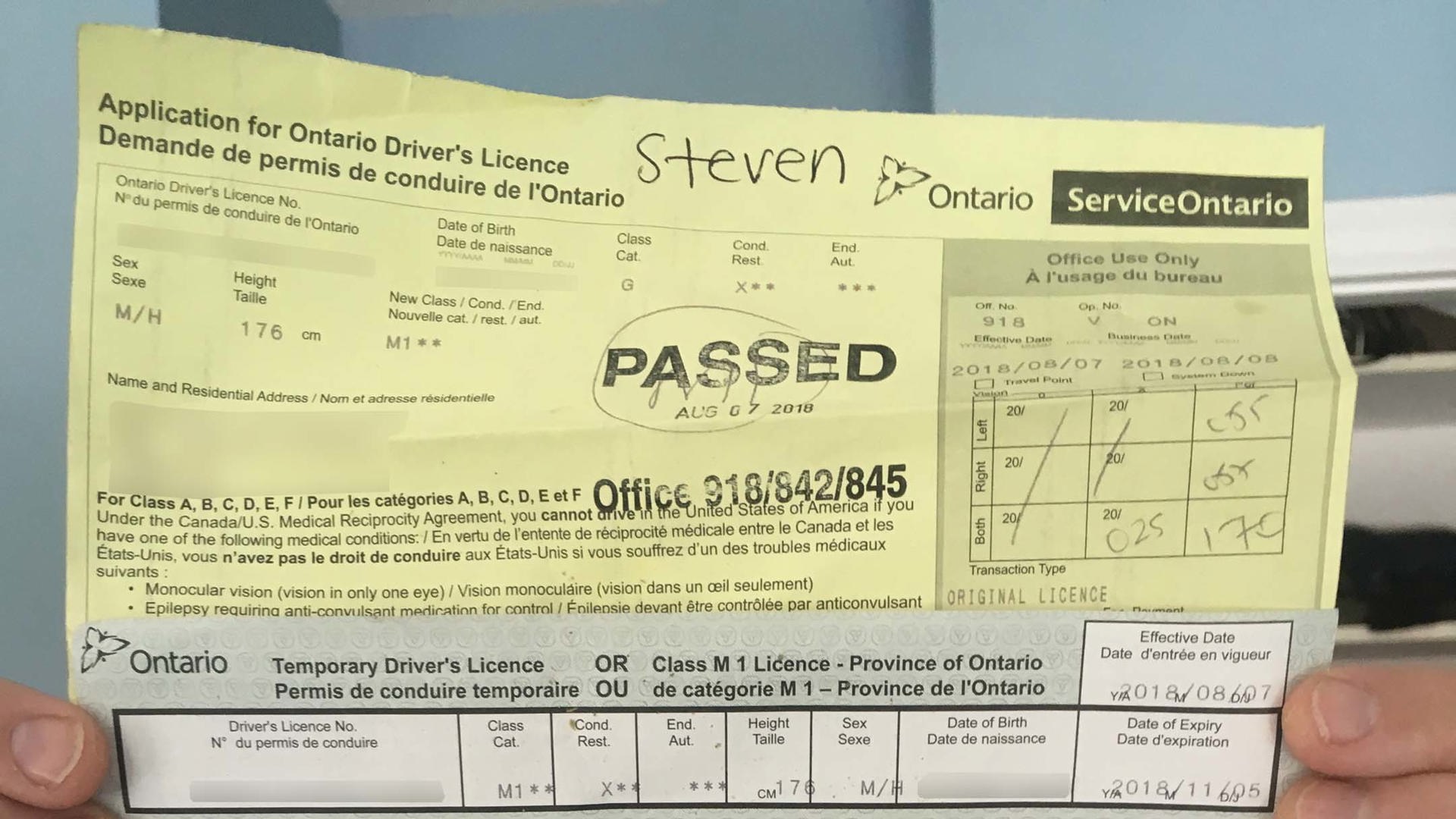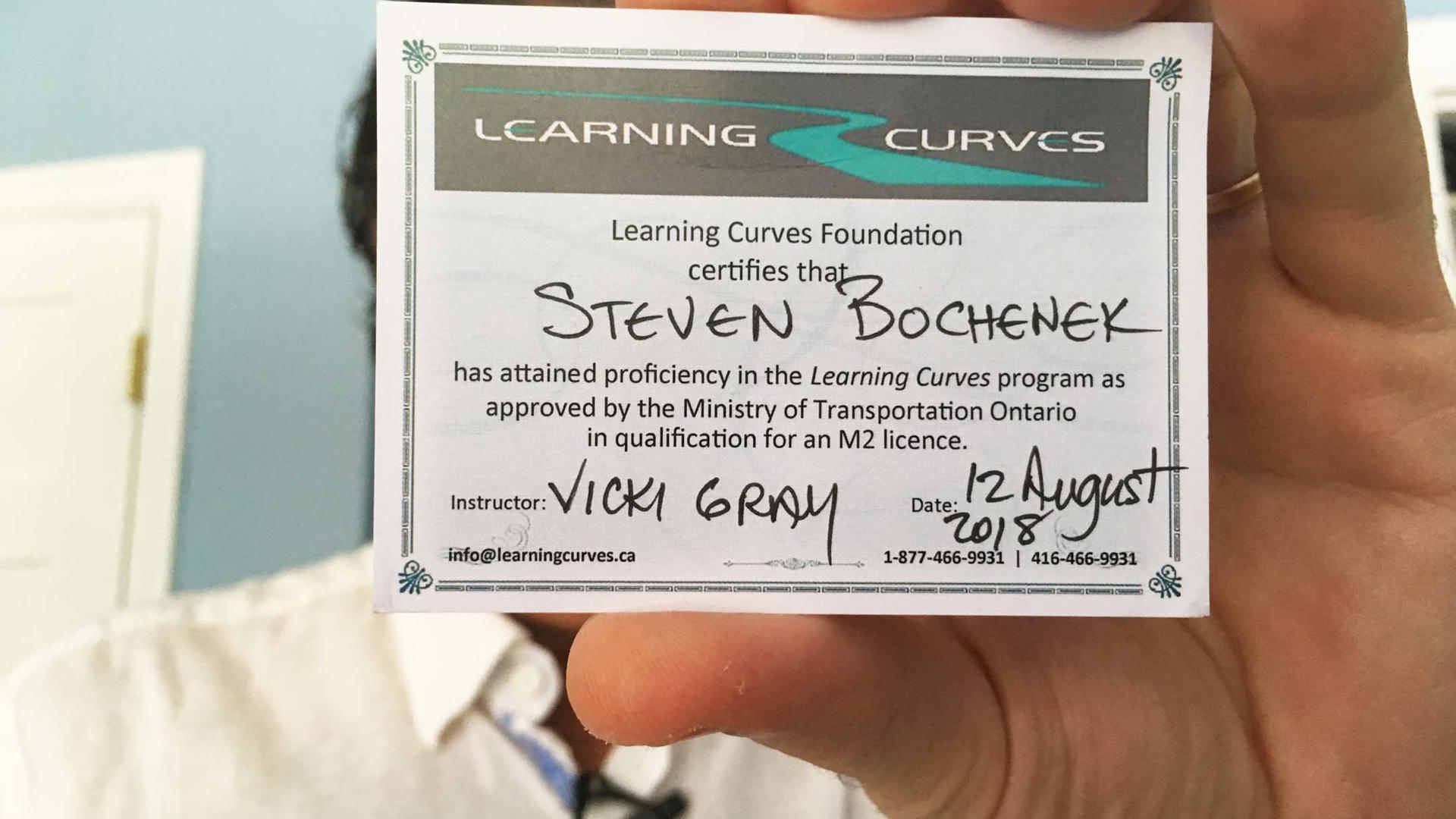“Assume you’re invisible when you’re on a motorcycle.” The Learning Curves motorcycle training school’s instructor Vicki Gray is so petite, she could almost use Malibu Biker Barbie’s leathers for riding. Maybe. If Mattel were to take them in two inches. She may be small but races superbikes and has taught motorcycling around the world since 1985. Everything from racing lessons in macho St. Martin to gymkhana in Japan. Vicki’s credentialed, and a compelling instructor.
“If it fits in a skillet, kill it.”
“Once you assume you’re invisible, there’s no sense getting upset when someone cuts you off, because you will be cut off!”
In the Classroom
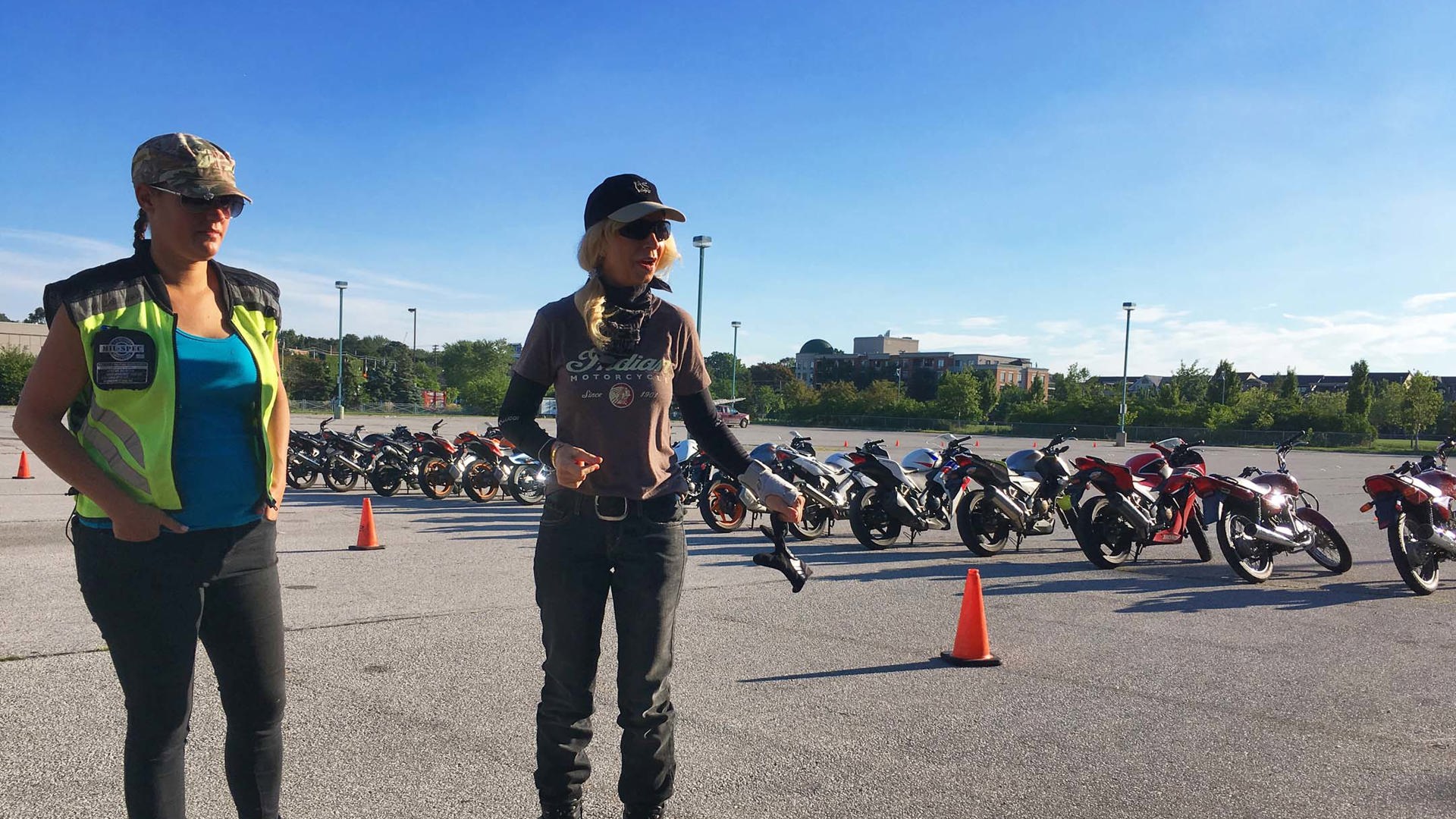
Vicki and her co-instructors Anne Maggio and Jen Orange will deliver countless lessons with such memorable bite-sized bits over the next few days. It begins tonight, a Thursday, with 15 students in a classroom for three hours discussing Traffic, Licensing, Gear, Insurance, and Risks. Come Saturday and Sunday, we’ll apply that knowledge on real bikes.
To participate, we must bring leather boots that extend above the ankle; snug leather or thick denim jackets and trousers that cover all skin; riding gloves with, minimally, a thick leather palm; and a DOT-certified helmet.
Anne stresses the importance of quality equipment with an infectious maniacal laugh. “I’m hardcore. I ride right through, all year ’round. I got soaked but rode two nights ago during that storm.” We’re gobsmacked. That summer gale was a record-breaker. A less-balanced mayor would’ve called in the army to clean up after. Yet, two nights later she’s here, rubbing her bleached Mohawk and laughing, confirming her hardcore credentials.
Yes, we all agree riding under the influence of any drug is deadly.
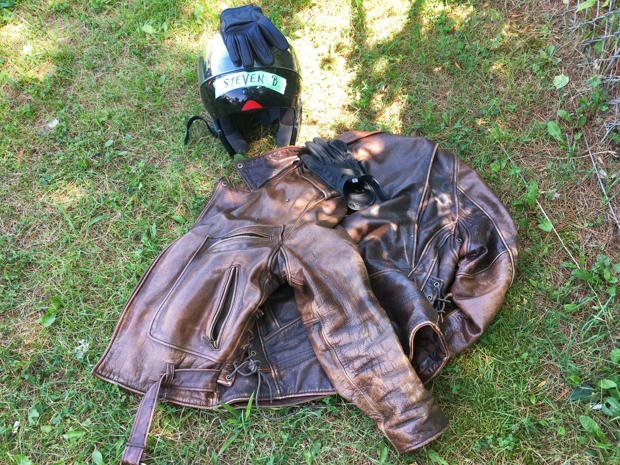
“But so is riding fatigued.” Jenn leads the final lesson, Risks. Riding into a rising or setting sun presents its own dangers, as does riding in an avoidable construction zone. You need to think before riding at night, or in the rain, or around or over an animal, and so on.
Wait. Riding over an animal? Each decision has its concomitant risks. Leaving your lane to save a squirrel could kill you, and others, “and you can’t predict where it’ll go; you can only decide where you’re going.” Understand the risks before deciding to ride. Capping off the evening, and speaking of bite-sized mnemonics, what’s Jenn’s rule regarding surprise wildlife in your path? “If it fits in a skillet, kill it.”
Day One: Getting Started
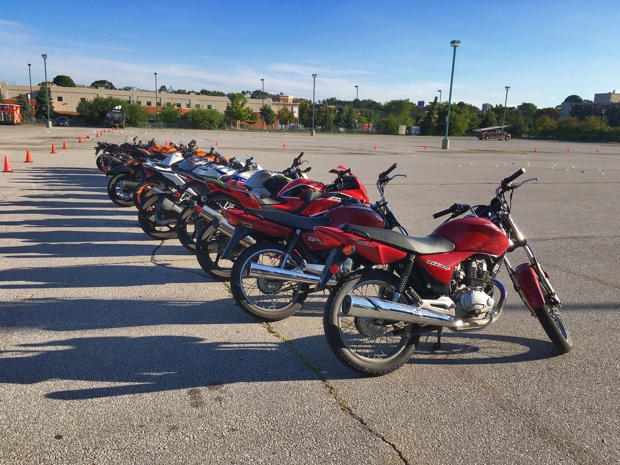
Saturday, 8 am, the wet heat already feels like a bear-hug from a homeless man.
Learning Curves has rented a third of the parking lot in Toronto’s Greenwood Park, where the old raceway used to stand. A strip of poplars separating the vast public greenspace from the baking blacktop provides meagre metres of shade. It’s already shrinking.
They’ve rolled a variety of motorcycles from a steel transport container for training: diminutive standards, old classics, several spirited sport bikes, and even some cruisers. All the bikes are on the lighter side of the cc spectrum but present more than enough power to hurt ourselves on.
Spoiler alert – Learning Curves passes a huge majority of attendees. Their secret: teach to the test. Over the next two days, we will focus on skills, skills, skills. Most exercises will require low-speed operation for a few dozen metres at most. Then execute, ride round to the back of the line and repeat. There will be zero pleasure-riding, circling the parking lot. Just short blasts of increasing challenges.
The M2 demands specific skills students must demonstrate within timelines.
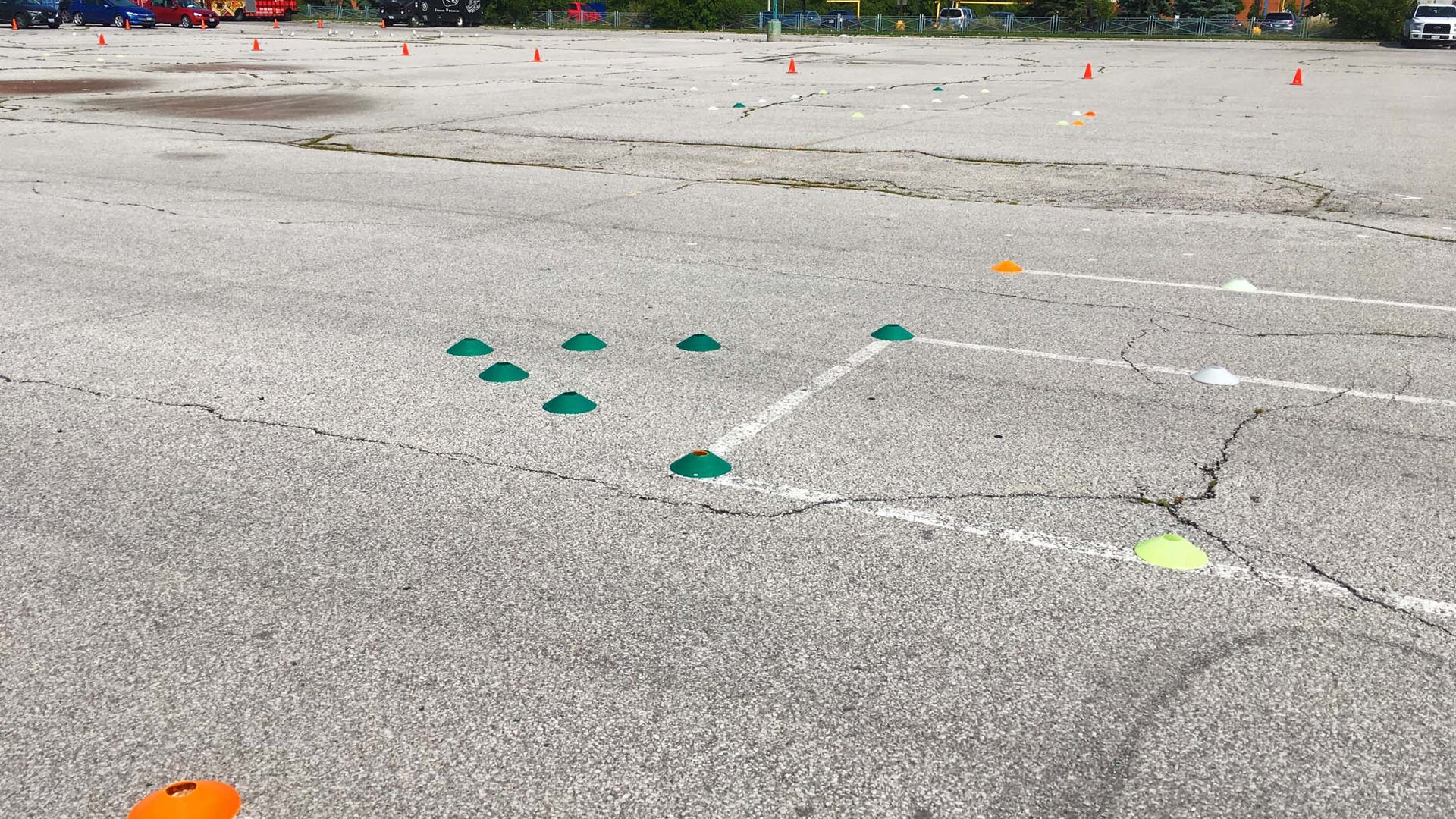
We’ll practice stopping in a curve; push-steering hazard avoidance; emergency braking from speed within a defined space; negotiating a tight turn in a lane narrower than a Republican’s mind, then gearing up to speed before precision stopping within a lined box smaller than a hopscotch step. But we’re getting ahead of ourselves.
Saturday morning, that’s all still theory. They’ll teach this mountain of knowledge in steps, each balancing on the previous.
Most students’ chosen bike becomes their mate for the rest of the course because they want to pass the impending M2 exam and each bike contains its own unique Learning Curve, as it were. More than once, I would feel ambivalence over my choice of the spunky Honda CBR 250R. The R stands for “racing”. Few racing vehicles are easy to control in first gear. However, first gear factors into every aspect of the examination. [Oh dear, Steve… let us show you a real racing bike… – Ed.]
Our introductory lesson entails rolling a bike off its kickstand, balancing and walking it safely before mounting it. The second part of the exercise pairs students up. One pushes; the other is astride. The point? Positioning. Where hands go; finding levers; knees hugging the tank; feet; and braking.

Despite the early hour, the rest of the parking lot is filling fast. Today is Paws in the Park, a marketplace and fun festival for dogs and their doting owners. Most participants parking nearby have yappy toy breeds. More than one makes a mad bid for freedom from their overheated CUV-saunas and into our tarmac cone-a-rama. We may be forced to make Jenn’s “skillet–kill it” decision.
Speaking of her mnemonics, Jenn teaches the next lesson describing the list of starting operations as a “rainbow”, flowing from the left to the right. How? Once astride the bike with both feet on the ground, you push away the kickstand (nearly all motorcycles have a leaning kickstand on the left). Then you clutch the lever at your left hand; turn on the ignition, typically just beneath the middle of the instrument panel; move the kill switch beside that to off; then press the start button, beneath the kill switch. Rainbow! Older bikes and specialist models vary but the order works in most cases. When turning off the bike, you rainbow in reverse order.
“You should be able to do this without looking down very soon.” Indeed, before we continue, rainbowing on and off is almost second nature but for the location of the kickstand in up position. My size 12 leather army boot with its two-inch heel leaves little sense of touch.
Now that we can start our bikes, the next lesson requires finding first gear’s friction point and riding away from still for a few metres – or feet. I have no trouble with the tasks.
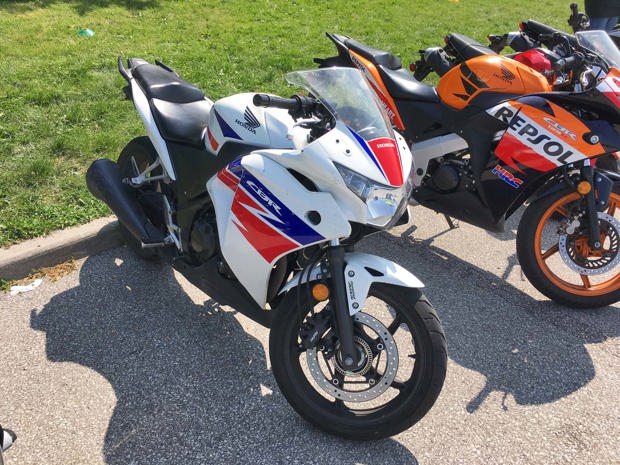
Indeed, the launch is a revelation. It’s a short ride, but I love this sensation of single-track motion that didn’t require pedaling and can’t wait to just ride around the compound for a few minutes. Too bad! Time for the next lesson.
“Anybody can go fast on a motorcycle,” Vicki says. “What takes skill is riding slow.” It’s an essential skill, too, requiring primarily the throttle (right handle) and rear brake (right foot lever), minimizing the use of the clutch (left hand lever) and front brake (right hand lever). Your front brake controls between 70 and 80 percent of your braking power, depending on your bike, the rear brake the remaining 20 to 30. Riding slowly for control is the only time you shouldn’t use both brakes when riding.
Did I mention there’s a lot of knowledge to upload?
It’s actually kinda fun and allows my left forearm a chance to rest. I already sense arthritic reminders in my fingers, echoes of injuries sustained from operating a jackhammer one summer in my twenties, plus the pre-hints of an impending blister on my palm. The fun is over soon enough with complicated right- and left-turn exercises added to slow riding.
They work us hard.
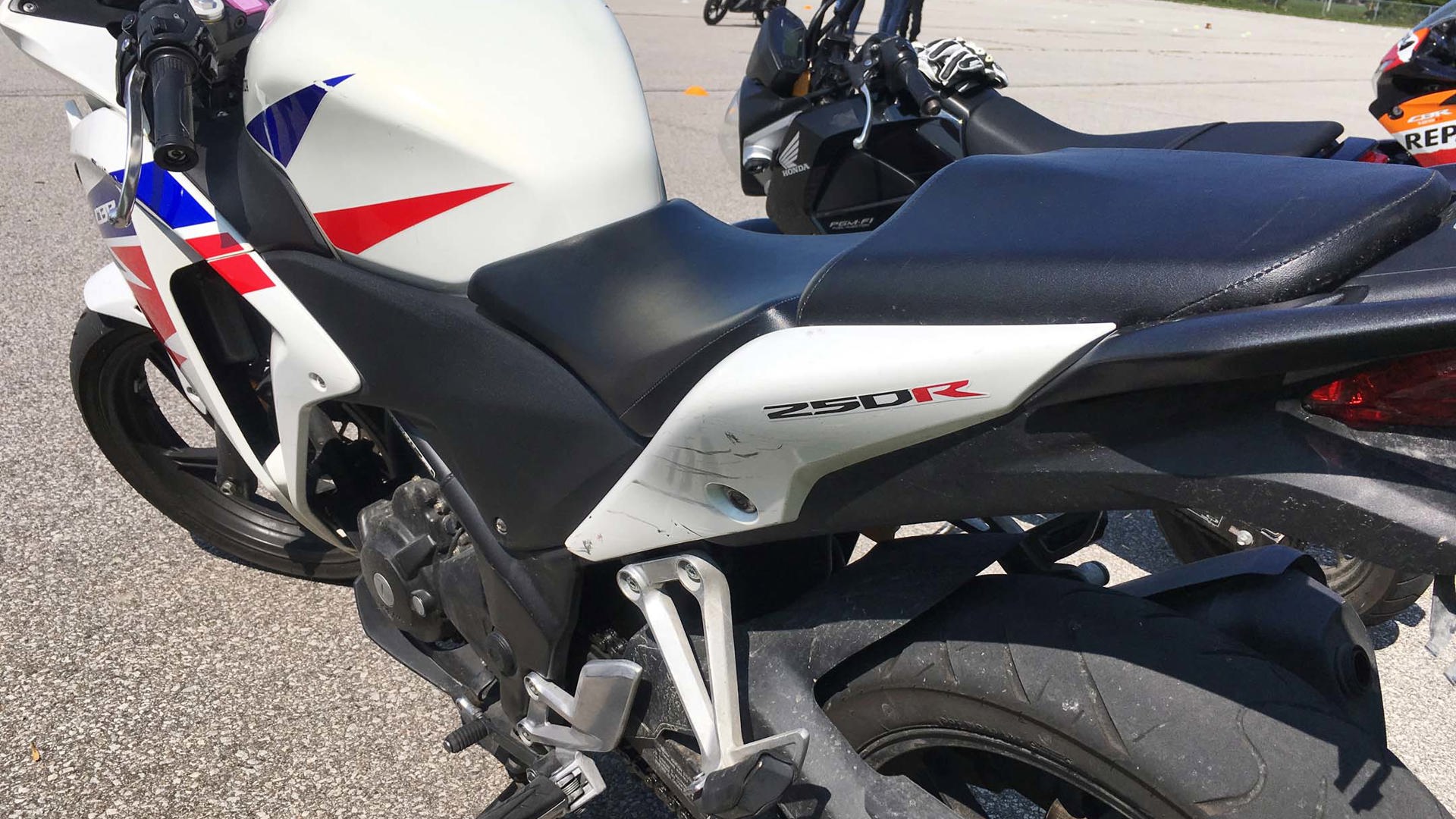
Next exercise, we finally get to move past second, into third – but only to compound this new skill with another: downshifting quickly back to first. The point? “Not locking up, and matching engine speed to road speed.”
Simply downshifting without braking is effective to slow your motorcycle but a dangerous habit to develop. Only the brakes activate the brake lights, alerting traffic behind that we’re decelerating. “Shift down and brake at the same time.”
All this information, delivered in apocalyptic heat, is becoming overwhelming. I begin forgetting to clutch before tipping up or tapping down my foot to shift. The CBR 250R stalls more than once. In the nick of time, we’re given an hour off for lunch and recovery. In the afternoon, we’ll learn push-steering, then cornering techniques.
The clutch demands a measured release, the throttle a parent’s loving caress.
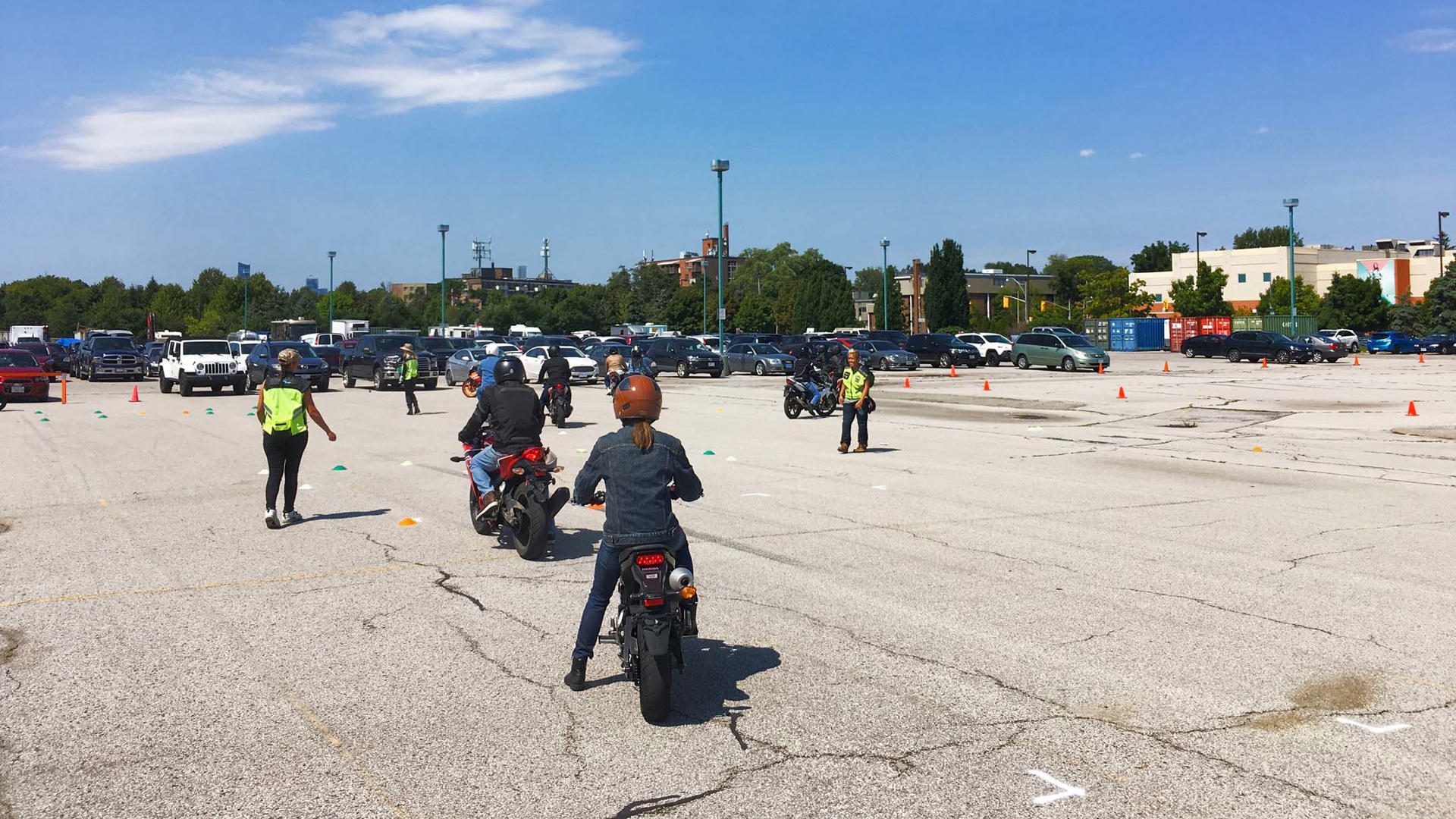
Overthinking too much, I constantly clunk away at both, like a ’60s robot monster in hockey gloves. The exercises are demanding, the sun and humidity relentless, my 40 lb dark-brown jacket rudely insulating, and barrage of advice hard to remember sequentially. I gradually feel my control dissipating. Just getting into and maintaining first gear without stalling or revving high enough to break glass in a concert hall becomes a 50/50.
It seems the only time my Honda sport bike’s revs aren’t echoing off the Scarborough Bluffs 10 km down the road is when I stall. It’s forgiving enough, re-starting promptly after each stall, but any machine would fatigue under such clumsy technique.
The value of the course is brought home. Maintenance of their training fleet alone must swallow a significant portion of their $475 student fees.
Day Two: Getting Tested
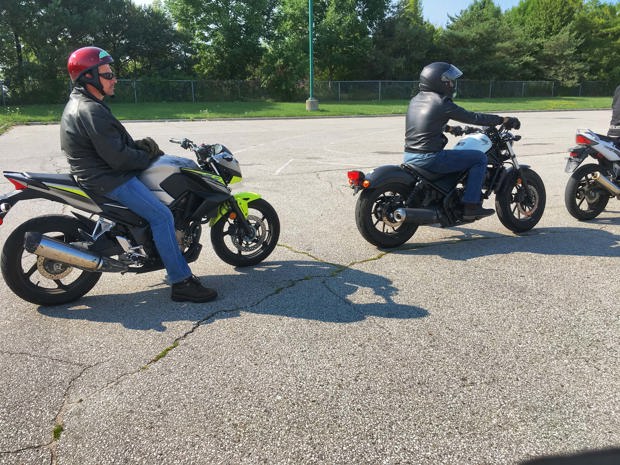
Starting with defensive traffic practices and ending with the M2 exam.
Vicki tells us, we’ll learn about “communicating in traffic and thinking where our path is.” In theatre and film, “blocking” is the physical plotting of actors by the director. The same goes for experienced motorcyclists, and then some. Experienced riders plot their ride strategically, quite literally “blocking” cars from entering their lane by making themselves apparent and communicating intentions.
Example? In the left lane, you typically ride in the right “track”, the line that a car’s right wheels would form. Conversely, riding in the right lane, you use the left track to block vehicles entering your lane from the right or attempting to pass from behind. If you were in the right track, they could interpret the action as you encouraging them to squeeze through your remaining lane space.
With so many skills to onboard, our exercise is decidedly more complicated than riding comfortably in third gear in a pretend left track. Instead, after a short few metres in second, we must right hand-signal, gear down and brake, gently slowing to a stop that angles the bike diagonally from the left to right track, inches before an imaginary stop sign. That’s the set of steps. The reality of the exercise for most of us, certainly me, gets decidedly jumbled.
Practice. Do it again. Repeat. Got that? Do it again.
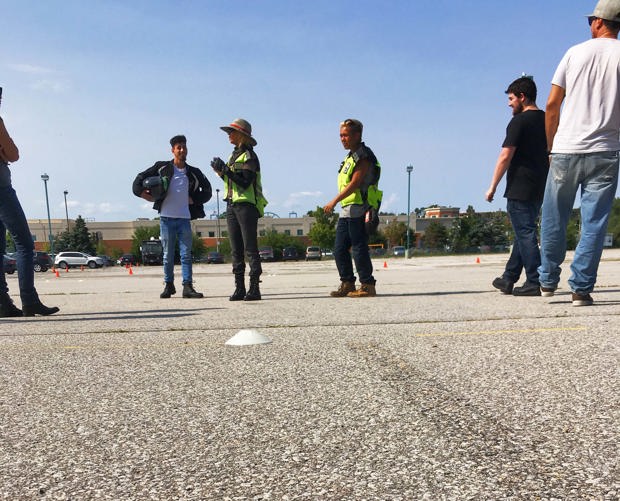
Next, we learn and practice collision-avoidance high-speed manoeuvres; stopping quickly; swerving to avoid an object; combining swerving before controlled stopping; lastly, slowing and stopping in a corner, “such as an off-ramp”.
By 11 am, my tiring left forearm and arthritic knuckles are at it again, making it harder to practice these many skills slowly. Indeed, by now I’m starting to worry whether I’ll even pass the exam because I’m losing the ability to easily take the bike into second. At least half the time, it simply shifts into neutral, the bike screaming like a jungle cat while I throttle more.
Ever observant, Vicki suggests hooking the shifter with the ankle locked, lifting my foot from the knee rather than just tilting up the foot. I try it and presto! Great advice! That’s one worry gone for the rest of the day. She’s Yoda in a fluorescent green traffic vest.
As for getting into and staying in first? “Maybe try one of the cruisers, instead of the sport bike. You might find it easier.” I switch with Goran, a huge chap close to my age who used to ride motorbikes along the picturesque Dalmatian coast in his teens. “You’ll like this better,” he agrees, handing over the keys to a Honda Rebel 300. “Lower centre of gravity, higher bars, better control.” He’d been riding it for a half hour, having switched with Moneeb who’d been on it all yesterday and this morning.
The Rebel’s ignition is near my left knee so yesterday’s start sequence is jumbled. But the rainbow operations are already ingrained and re-ordering them slightly seems paltry. It’s hard to believe that just yesterday I had to think it through in steps rather than as a single system.
Then comes lift-off. The improvement in my riding is immediate.
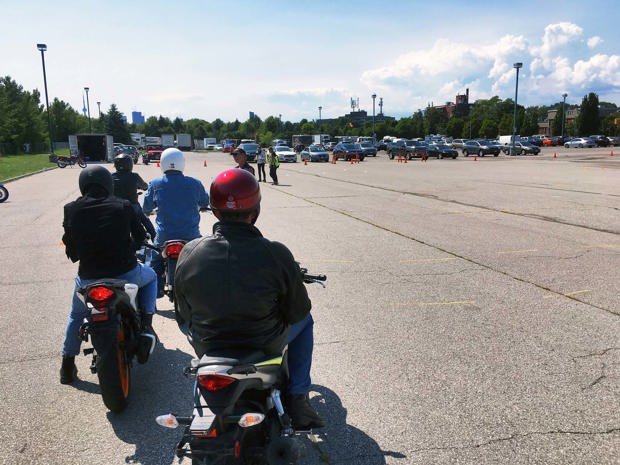
I love the feel of the Rebel and never stall once during the next half hour. With this simpatico machine under my command, the exercises become our bitch. I’m a unicorn in leather boots.
“It’s great isn’t it?” observes Moneeb. “I want it back to for the practice and exam this afternoon.” Damn, I was hoping for the same. Understandably, students become possessive of their chosen bikes on these weekends, not wishing to learn another suite of riding characteristics too. We have enough on our skillets. I surrender the keys.
Next, the instructors walk us through the six exercises that will become our exam later today. We’ll have 45 minutes to practice them.
Back on the CBR 250R, I resume negative thinking, losing even first gear now. Then Goran pulls up beside and coaches me. “Forget everything else and focus only on the friction point. Let the clutch out slowly and when the bike starts to move itself, pull back the clutch just a centimetre. Play with it there, back and forth. You barely need the throttle at all.”
I take his advice, focus only on clutching. The riding gets easier. “Don’t worry who’s behind you. Even if it takes 20 seconds to find that point and gently let the clutch go. Almost no throttle.”
The CBR 250R gently rolls away with no jolts or stalls from sudden clutch releases and no screeching throttle. Maybe I can do this. My confidence increases.
If Vicki is my Yoda, Goran becomes my Wookie co-pilot.
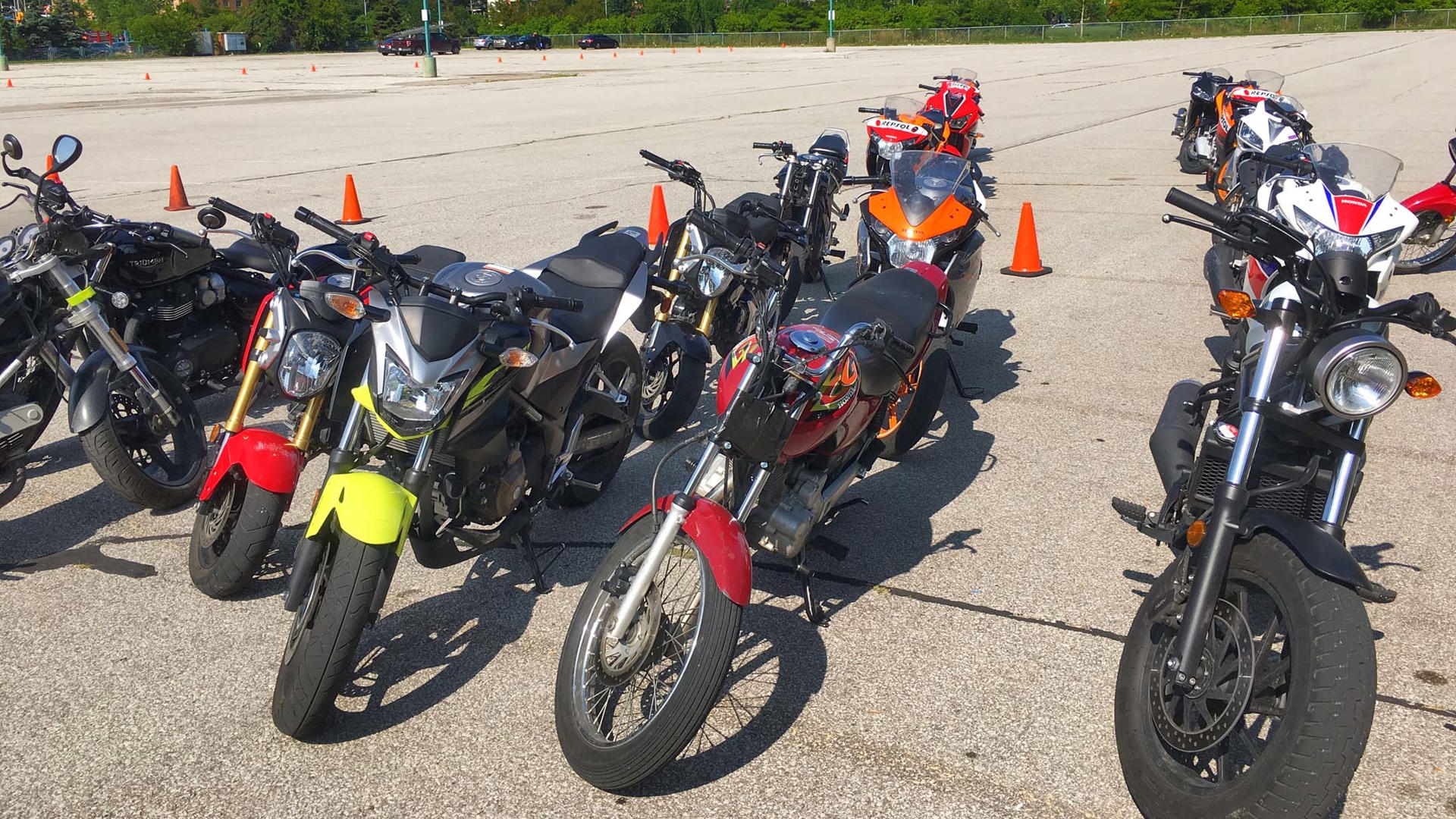
Six technical exercises comprise the exam. Marking allows few mistakes. Vicki reports that we’re allowed a total of 11 demerit points to pass. 12 gets you a free do-over next week if you want it. 13 plus? Well that number says it all. Still, 11 sounds doable.
Anne and Jenn advise, “Don’t worry about anything except exactly what each exam exercise demands.” So, if you don’t need to be in second gear to complete a time-limited task, don’t add extras. If you go the wrong way during a collision avoidance exercise, you’ll be reprimanded but not penalized because you still avoided the object.
Now, I have nothing to think about beyond gently tilting my right hand, as if handling a Fabergé egg, and gently releasing my left fingers, as if giving my daughter away at her wedding (to someone who’s not an asshole). I’m feeling more confident. Bring on the tests. Que sera sera.
We choose an order to perform all six tests in the same rotation. I’m fourth, right after Goran. We all mount and start our bikes one last time, form a line and slowly proceed to the first test, which most of us agree is the most technically challenging.
When it’s my turn, I follow Goran’s lead, looking left and right before proceeding, as though entering an intersection. That’s not on the test but a good habit to develop and impress the markers with.
Now. Go. Don’t hurry despite the stopwatch. There’s plenty of time.
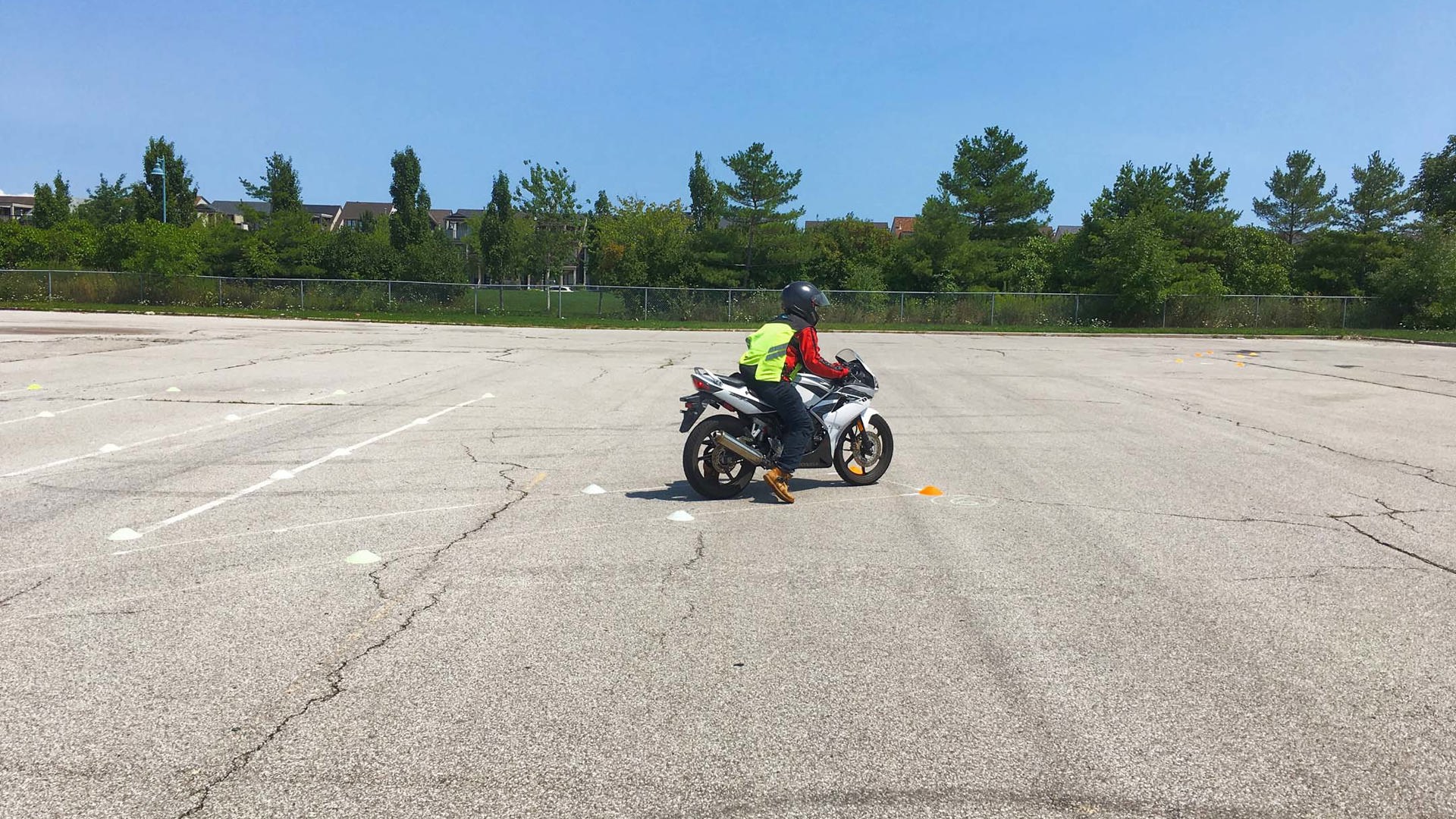
The world shrinks to only a gentle clutch and gentler throttle. I’m Zen, detached from the action, almost watching from above. Now thoroughly embedded in Goran’s tip, I widen focus to what this exercise entails. Head’s up and right, rear braking foot communicating with gently throttling right hand.
Early success! I don’t leave the track and thus don’t earn 5 demerits! I still need to complete the exercise in under 7.2 seconds. Rather than attempting second gear, I intentionally screech this responsive jungle cat, for once, then perform the quick stop – my most easily assimilated lesson of the day – precisely within the box, all without thinking. The hardest exercise is over! The confidence grows.
The rest of the exercises are performed within the same Zen state. By my third, I’m thinking I just may pass. After five, I know it. I don’t even remember doing the sixth.
Soon we’re removing our soaking gear while Vicki does some quick tallying. Then she makes an announcement.
“Would the following four people come up here.” Uh oh, my name’s first.
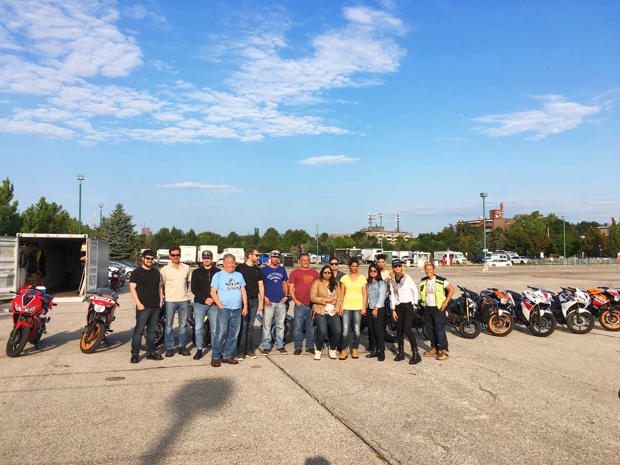
We, the summoned, nervously congregate around Vicki. Thoughts race. Did we fail? What’ll they say back in Etobicoke? Why wasn’t that one over there failed too? She’s way worse than me.
“You passed,” she quietly smirks. Louder, she proclaims, “You all passed!”
Smartass! We’re elated, tempted to throw our helmets in the air like mortarboards but any scratches on the surface of your helmet render it unsafe. At speed, a scraped surface can be gripped by a rock or divot in the road. “A scratch can catch” could be the newest mnemonic for our instructors’ repertoire.
Vicki sits individually with each student and breaks down what needs work. I’ve received just three demerits and express surprise given my riding as late as 11 am today. “Some people perform best under pressure,” says Vicki, again channeling Yoda. How? My three points were earned in the final challenge when, I admit, I was no longer focussed.
The following is verbatim. “Your tire touched the outside line which is usually a side effect of not looking ahead as well as a combination of balance/manoeuvring control. More control is expected of you in this scenario as the weight of the motorcycle becomes more relevant while slowing and turning.”
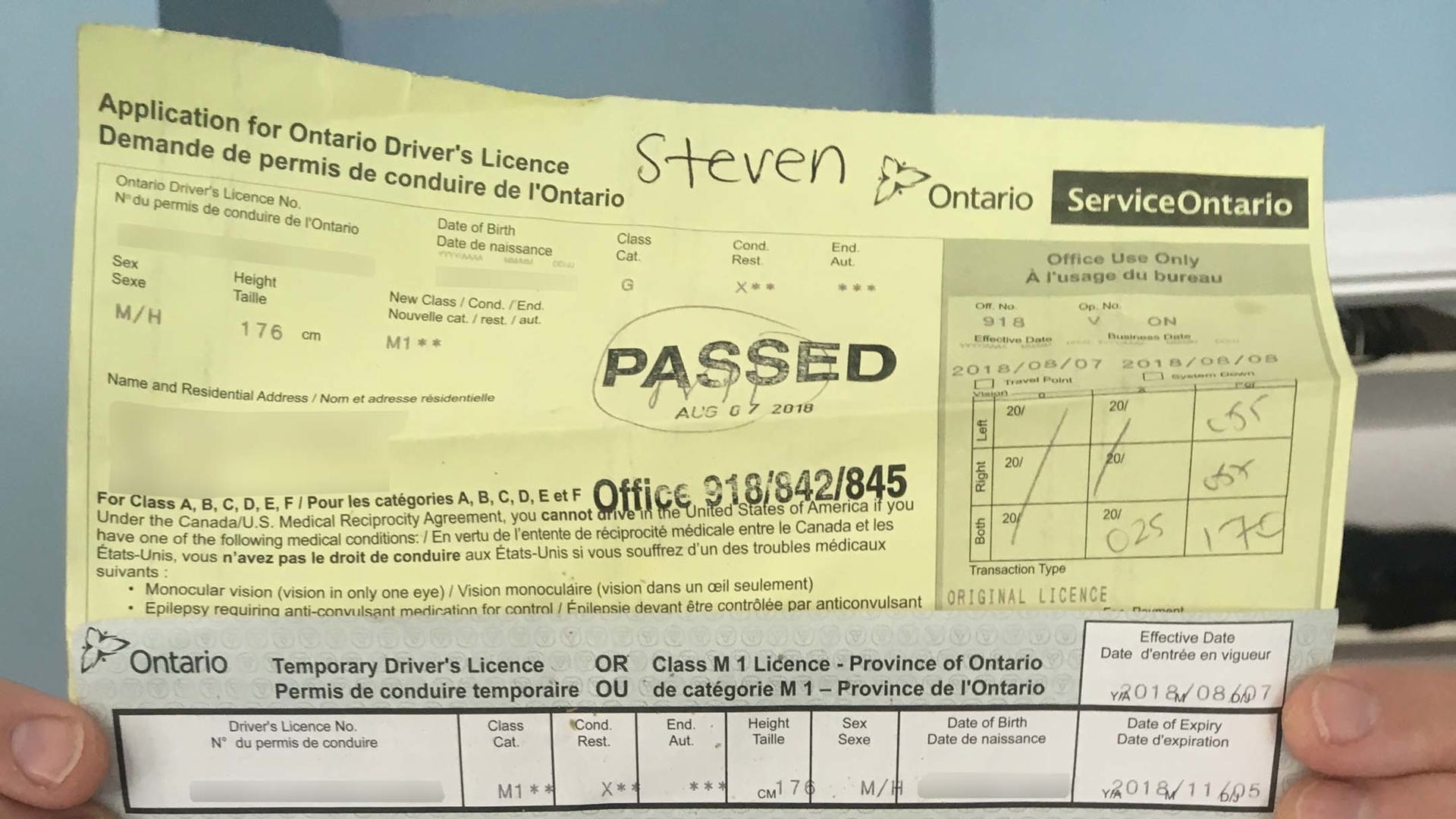
See? Lots to remember!
While each student has their me-time with Vicki, Anne and Jenn lecture the relieved others about motorcycle maintenance and riding in groups. “It’s good to push yourself, but never ever ride with people you don’t trust, or attempt something you don’t feel comfortable with.”
For instance, just because I’m legally entitled to ride on the 401 once my M2 is validated, it doesn’t mean I should. For one thing, I don’t own a motorcycle.
